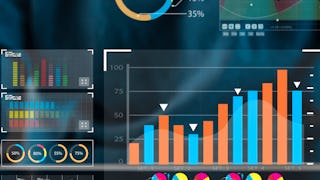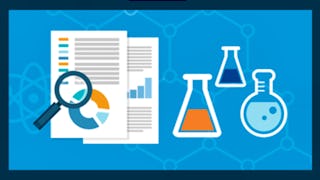In an increasingly data-centric world, the ability to derive meaningful insights from raw data is essential. The IBM Data Analyst Capstone Project gives you the opportunity to apply the skills and techniques learned throughout the IBM Data Analyst Professional Certificate. Working with actual datasets, you will carry out tasks commonly performed by professional data analysts, such as data collection from multiple sources, data wrangling, exploratory analysis, statistical analysis, data visualization, and creating interactive dashboards. Your final deliverable will include a comprehensive data analysis report, complete with an executive summary, detailed insights, and a conclusion for organizational stakeholders.

Unlock access to 10,000+ courses with Coursera Plus. Start 7-Day free trial.

IBM Data Analyst Capstone Project
This course is part of IBM Data Analyst Professional Certificate



Instructors: Rav Ahuja
82,348 already enrolled
Included with
(1,316 reviews)
Recommended experience
What you'll learn
Apply techniques to gather and wrangle data from multiple sources.
Analyze data to identify patterns, trends, and insights through exploratory techniques.
Create visual representations of data using Python libraries to communicate findings effectively.
Construct interactive dashboards with BI tools to present and explore data dynamically.
Skills you'll gain
Details to know

Add to your LinkedIn profile
See how employees at top companies are mastering in-demand skills

Build your Data Analysis expertise
- Learn new concepts from industry experts
- Gain a foundational understanding of a subject or tool
- Develop job-relevant skills with hands-on projects
- Earn a shareable career certificate from IBM

There are 6 modules in this course
In this module, you will apply key concepts in data collection and analysis through APIs and web scraping. You will begin by analyzing HTTP requests and utilizing the GitHub REST API to retrieve and paginate job postings for various technologies. Next, you will collect job data from the GitHub Jobs API. Additionally, you will perform data collection using web scraping techniques, including downloading webpages, scraping links and images, and extracting data from HTML tables to write into a CSV file. The module also includes a graded quiz to test your knowledge.
What's included
2 videos1 reading4 assignments5 app items3 plugins
In this module, you will perform essential data-wrangling techniques necessary for cleaning and preparing datasets for analysis. Throughout the module, you will engage in hands-on activities to identify and handle common data issues, including duplicate entries and missing values. You will strategically remove duplicate records, apply suitable imputation strategies for missing data, and normalize datasets to ensure consistency and accuracy. Additionally, you will have a graded quizz to assess your understanding and reinforce the concepts covered.
What's included
7 assignments6 app items1 plugin
In this module, you will engage in essential exploratory data analysis (EDA) techniques to uncover meaningful insights from your data set. You will start by identifying the distribution of the data through plotting distribution curves and histograms, which are crucial for understanding how values are spread across different features. Next, you will detect outliers that may skew your analysis and learn how to effectively remove them to ensure data integrity. Additionally, you will explore correlations between various features in the data set, revealing relationships that can inform your overall analysis. Finally, you will create a new DataFrame to organize and present your findings. The module includes a graded quiz to test your knowledge.
What's included
1 reading5 assignments4 app items
In this lab, you will perform essential data visualization techniques to extract meaningful insights from the Stack Overflow survey data set. You will start by visualizing the distribution of data using histograms and box plots to understand the spread of compensation and age. Next, you will explore relationships between features through scatterplots and bubble plots, followed by examining the composition of data with pie charts and stacked charts. Additionally, you will compare data across categories using line and bar charts. The module includes a graded quizz that will assess your knowledge of these concepts, ensuring you are well prepared for further analysis in your final project.
What's included
6 assignments9 app items1 plugin
In this module, you will create dashboards using Stack Overflow survey data using either IBM Cognos Analytics or Google Looker Studio. The assignment is divided into Part A: Building a Dashboard with IBM Cognos Analytics and Part B: Building a Dashboard with Google Looker Studio. You will design a dashboard with sections on Current Technology Usage, Future Technology Trends, and Demographics. After completing the assignment, you will be required to submit the link of the Cognos or Looker Studio dashboard you complete. The module also includes a checklist that helps you ensure you have completed all necessary tasks before moving on.
What's included
2 assignments3 plugins
In the final module, you will focus on presenting your data findings effectively. You will begin by exploring key elements contributing to a successful data findings report, including structuring your report, using best practices for data visualization, and presenting complex information in an engaging, accessible format. The module also includes labs covering basics in PowerPoint, foundational presentation techniques, and saving your presentation as a PDF to ensure a polished, professional final product. Finally, you will complete and submit a final presentation that highlights insights derived from the Stack Overflow Developer Survey data. Your final assignment will be graded by one or more of your peers, and you will also evaluate the work of a peer who has completed this capstone project.
What's included
2 videos3 readings1 peer review5 plugins
Earn a career certificate
Add this credential to your LinkedIn profile, resume, or CV. Share it on social media and in your performance review.
Instructors



Offered by
Explore more from Data Analysis
 Status: Free Trial
Status: Free Trial Status: Free Trial
Status: Free Trial Status: Free Trial
Status: Free Trial Status: Free Trial
Status: Free Trial
Why people choose Coursera for their career




Learner reviews
1,316 reviews
- 5 stars
77.37%
- 4 stars
15.26%
- 3 stars
4.17%
- 2 stars
1.13%
- 1 star
2.05%
Showing 3 of 1316
Reviewed on Sep 26, 2021
Great. I practiced data visualization on IBM's Cognos Analytics software. It's a great piece of software. I then learned how to make a presentation to present the results of the analysis.
Reviewed on Aug 19, 2023
Very good course. Some hiccups with IBM tokens. Very good interaction with Staff when problems are encountered
Reviewed on Aug 30, 2022
Comprehensive and straightforward. Love every aspect especially the labs and peer reviews.

Open new doors with Coursera Plus
Unlimited access to 10,000+ world-class courses, hands-on projects, and job-ready certificate programs - all included in your subscription
Advance your career with an online degree
Earn a degree from world-class universities - 100% online
Join over 3,400 global companies that choose Coursera for Business
Upskill your employees to excel in the digital economy
Frequently asked questions
Data analysis is the process of inspecting, cleaning, transforming, and modeling data to uncover useful information, make informed decisions, and support business strategies. It involves techniques such as statistical analysis, visualization, and reporting to identify trends, patterns, and insights from datasets.
When you subscribe to a course that is part of a Certificate, you’re automatically subscribed to the full Certificate. Visit your learner dashboard to track your progress.
This course is completely online, so there’s no need to show up to a classroom in person. You can access your lectures, readings, and assignments anytime and anywhere through the web or your mobile device.
More questions
Financial aid available,
¹ Some assignments in this course are AI-graded. For these assignments, your data will be used in accordance with Coursera's Privacy Notice.

